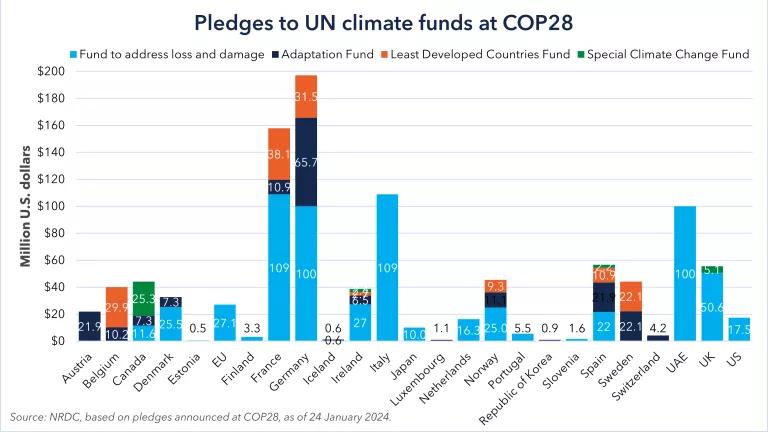The Good, the Bad and the Urgent: MDB Climate Finance in '21
A look at the key findings from the multilateral development banks' joint report on their climate finance in 2021
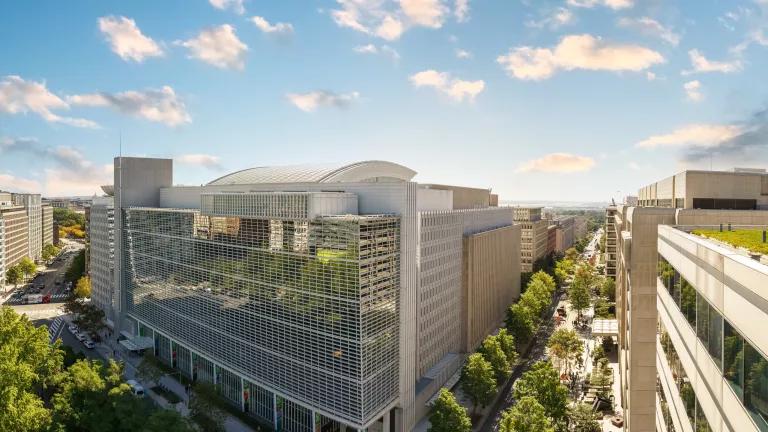
View of World Bank Group main headquarters in Washington, DC
This blog was co-authored with Carolyn Neunuebel and Esther Choi at the World Resources Institute, and originally published at WRI.org
Multilateral development banks (MDBs) are a major source of public climate finance, and the funding that helps reduce greenhouse gas emissions and adapt to the impacts of climate change. MDBs usually publish a Joint Report on Climate Finance sometime between June and August to provide details of the prior year’s funding but were delayed this year.
This year’s report, released in mid-October, is somehow longer and messier than usual, yet lacks critical data compared to previous years – up to not even including numbers on each MDB’s overall financing.
As we’ve done in past years (see 2016, 2017, 2018, 2019 and 2020 editions), we analyzed MDBs’ 2021 Joint Report on Climate Finance to show key takeaways behind the headlines. The restructured approach and missing data made this considerably more difficult. Here’s a look at the good, the bad and the urgent findings.
Note: Since their 2019 joint report, MDBs changed the way they classify countries, making it more difficult to assess how their climate finance contributes to the $100-billion-a-year goal set under the UN Framework Convention on Climate Change (see box). Where possible, we adjusted figures to align with the previous categorization of developing countries.
Oranges to Grapefruits: MDBs Change their Country Classification Methodology
After the 2019 joint climate finance report, MDBs changed their reporting method to the World Bank’s income-based country classification system, which divides countries into “low-income,” “middle-income” and “high-income.” This is different from how the UNFCCC defines “developed” and “developing” countries, to which MDB climate finance reports up to 2018 broadly aligned. The UNFCCC definition of developing countries includes some countries the World Bank classes as high-income, whereas the World Bank’s low- and middle-income countries classification includes some countries that are classed as developed countries or economies in transition by the UNFCCC.
Data from the African Development Bank (AfDB), Asian Development Bank (ADB) and Inter-American Development Bank Group (IDBG) are not particularly affected by the change, since they only provide finance to developing countries under the UNFCCC definition. Figures from the European Bank for Reconstruction and Development (EBRD), European Investment Bank (EIB) and World Bank Group (WBG) vary because they provide finance to some countries considered developed according to the UNFCCC, causing a $8.1 billion discrepancy. MDB climate finance in 2021 to low- and middle-income countries was $50.7 billion using the current methodology, but using the previous definition, MDB climate finance to developing countries was $58.9 billion in 2021.
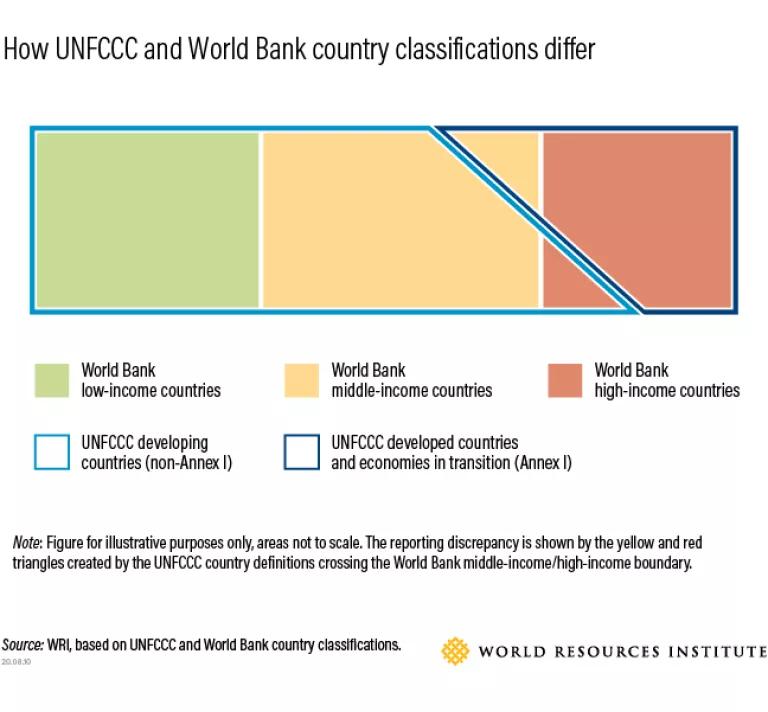
Before getting into the details, here is a breakdown of the MDB financing for developing countries by institution.

The Good:
1) Climate finance for developing countries hit a record high in 2021…
Total climate finance to low- and middle-income economies ($50.7 billion) rose by $12.7 billion (33%) from 2020 to 2021, and finance to UNFCCC-defined developing countries ($58.9 billion) increased by $13.5 billion (30%). At the UN Secretary-General’s Climate Action Summit in 2019, MDBs made a joint statement setting out their intention to grow their climate finance for low- and middle-income countries to $50 billion by 2025, of which $18 billion would be for adaptation. With this latest climate finance report, it appears they have collectively hit this goal four years early and are close to hitting the adaptation finance target.
This is especially welcome given that climate finance for developing countries had declined in 2020. It is also a $9.2 billion (22%) increase from pre-pandemic figures in 2019, or $12.4 billion (27%) for developing countries, just a smidge under the 28% increase from 2016 to 2017. However, inflation averaged 5.9% in developing countries in 2021 and only 4.5% in 2017. With inflation expected to average 9.9% in these economies in 2022, it is especially important for climate finance to keep pace with rising prices.
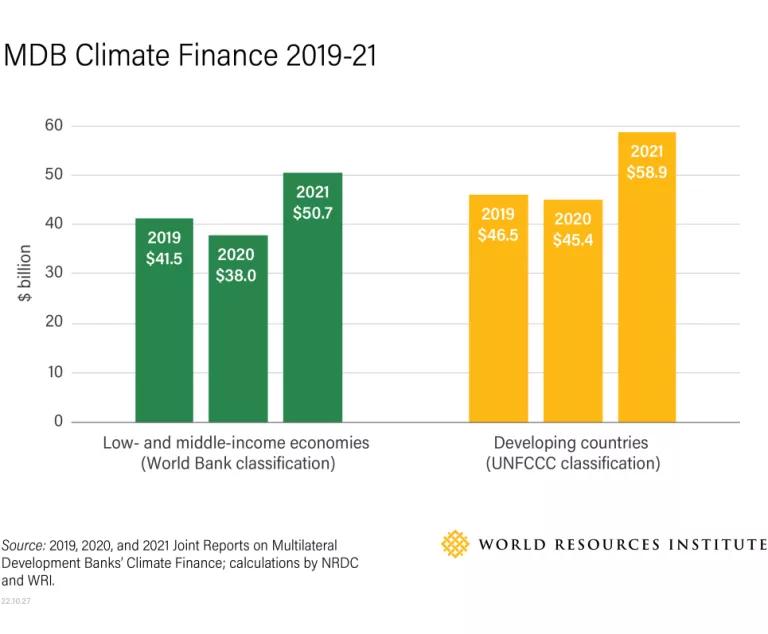
2) …and returned to pre-pandemic shares of overall MDB operations
The pace of growth in climate finance from 2020 exceeded growth in total operations for most of the MDBs. The WBG increased their total climate finance to developing countries by 30% from 2020, 11 percentage points more than the 18% growth in their total operations. On average across the MDBs that reported in 2019, the share of climate finance in overall operations grew from 31% in 2020 to 41% in 2021 – just slightly under the 42% average in 2019, indicating a return to pre-pandemic shares of climate finance in overall MDB operations.

3) All the MDBs have now set post-2020 climate finance targets, and some have already met them
The New Development Bank (NDB) set a climate finance target for the first time this year, aiming for 40% of overall financing to go to climate between 2022-26. The ADB appears off track to achieve its mid-decade goal of $35 billion in cumulative climate finance between 2019-24 but raised the “ambition” of its longer-term cumulative target from $80 billion to $100 billion by 2030 – noteworthy, given it will likely require a step-change for the bank to achieve, but more of an aspiration than an official target. While the Asian Infrastructure Investment Bank (AIIB) projects that it will reach $50 billion in cumulative climate finance by 2030, no other MDB has a longer-term target yet.
EBRD met their target for 50% of green finance in 2021. Other MDBs appear to be on track to achieve at least parts of their 2025 target–the Islamic Development Bank (IsDB) committed 31% of investments for climate finance last year, and AfDB prioritized adaptation finance, allocating 64% of climate finance to developing countries (the highest proportion amongst the MDBs).
MDBs’ Climate Finance Targets
| MDB | Pre-2020 Target | Post-2020 Target | On Track? |
| African Development Bank (AfDB) | 40% of approved finance per year by 2020 | At least $25 billion for 2020-25, prioritizing adaptation finance | $5 billion in 2020-21 |
| Asian Development Bank (ADB) | $6 billion by 2020; $4 billion for mitigation and $2 billion for adaptation |
$80 billion for 2019-2030 with interim target of $35 billion for 2019-24, and 65% of projects (by number of projects rather than amount of financing) on a three-year rolling average $100 billion by 2030 (rev in 2021), and 75% of projects supporting mitigation and adaptation |
$14 billion in 2019-21 |
| Asian Infrastructure Investment Bank (AIIB) | None | 50% of annual loan volume by 2025; expects to reach $50 billion by 2030 | 29% in 2021 |
| European Bank for Reconstruction and Development (EBRD) | 40% of annual commitments support green finance by 2020; $20 billion for 2016-20 | More than 50% of commitments support green finance by 2025 | 50% in 2021 |
| European Investment Bank (EIB) |
$20 billion per year for 2016-20 globally, equal to at least 25% of overall lending 35% of total lending by 2020 in developing countries |
More than 50% of operations support climate action and environmental sustainability by 2025 globally; 15% of climate finance to support adaptation €1 trillion of investments in climate action and sustainability from 2021-30 No developing country specific target yet |
41% in 2021 11% adaptation in 2021 |
| Inter-American Development Bank Group (IDBG) | 25-35% of commitments by 2020 | At least 30% of finance for 2020-23 | 25% in 2021 |
| Islamic Development Bank (IsDB) | None | 35% of overall annual lending by 2025 | 31% in 2021 |
| New Development Bank (NDB) | None | 40% of overall financing from 2022-26 | 10% in 2021 |
| World Bank Group (WBG) | 28% of annual commitments by 2020 | Average 35% of overall financing from 2021-25; 50% of IDA and IBRD climate finance to support adaptation and resilience | 32% in 2021 |
Notes: Text in italics denotes new commitments made since last year’s report. Figures in “On Track?” column are for climate finance to developing countries only.
The Bad:
1) Private sector co-financing rates, already disappointing, fell further in 2021
For years, MDBs have talked about prioritizing mobilizing private finance. But for all their talk, they don’t appear very good at it. In 2021, for every dollar of climate finance MDBs provided, they mobilized 25 cents in private finance, a fall from 26 cents last year. The World Bank Group and IDBG appear to have performed particularly poorly, despite including their dedicated private ‘arms.’
While there is broad agreement that we need to shift private finance away from climate-harmful activities and towards clean, resilient investments, there is substantial debate about the best ways for MDBs to achieve this.
Loans continue to dominate MDBs’ investment portfolio, accounting for 71% of their total climate finance in 2021. MDBs could be making greater use of a broader pool of financial instruments, such as guarantees, to encourage private sector investments. MDBs have tended to focus on incentivizing private investors by sweetening deals with public resources. Public subsidies for socially beneficial investments certainly have a role to play, but it is worth considering whether MDBs should be doing more to support governments with design of policy reforms, regulations and taxation to help shift private finance.
Moreover, MDBs’ policy advice could focus more on building governments’ capacities to regulate polluting activities, raise revenues equitably and invest in climate action. Developed economies such as the U.S. and EU are increasingly embracing green industrial policy as the most effective approach to achieving a rapid, just transition, and developing economies should be afforded the same opportunities to follow this path to climate prosperity.
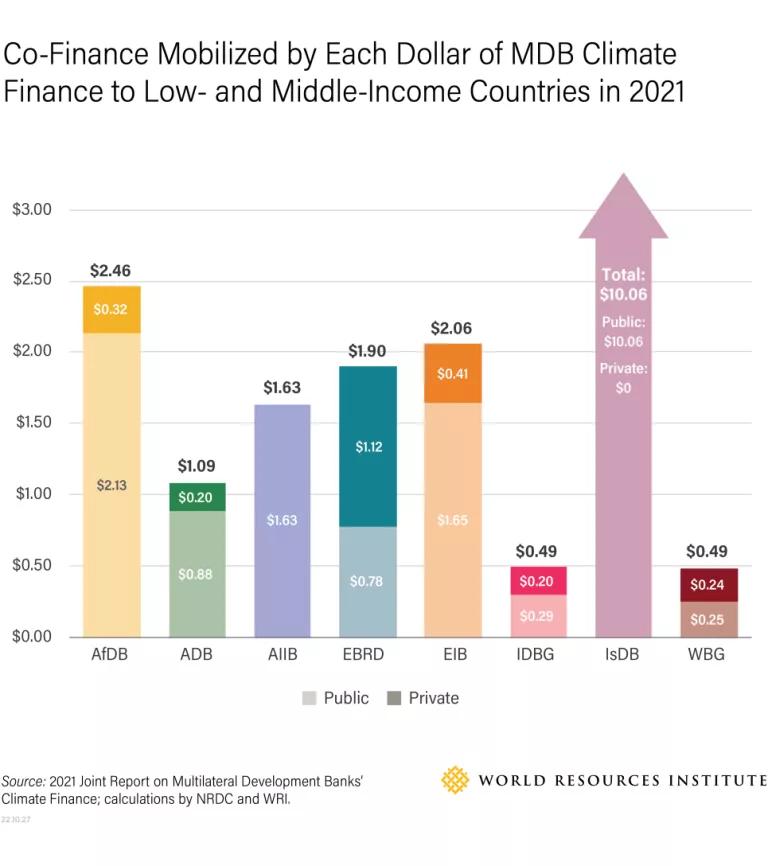
2) The share of climate finance to the most vulnerable countries fell for the first time since 2016
Small Island Developing States (SIDS) and Least Developed Countries (LDCs) are recognized in the Paris Agreement as particularly vulnerable to climate change. LDCs comprise some 13% of the global population and 69% of global deaths from climate-related disasters. The Intergovernmental Panel on Climate Change expects vulnerability in SIDS to rapidly rise as adverse climate impacts further constrain their adaptation options.
MDBs’ total climate finance to SIDS and LDCs rose by $1.3 billion (14%) in 2021 from 2020 but did not keep pace with the growth in overall climate finance to developing countries. The portion to SIDS and LDCs had risen steadily in the four years prior, from 12.6% of total climate finance to developing countries in 2016 to 22% in 2020. In 2021, however, the share dropped to 19%. Continuing to increase the share of climate finance going to the most vulnerable countries is critical to MDBs’ mission to eradicate extreme poverty, which has been on the rise since the pandemic.
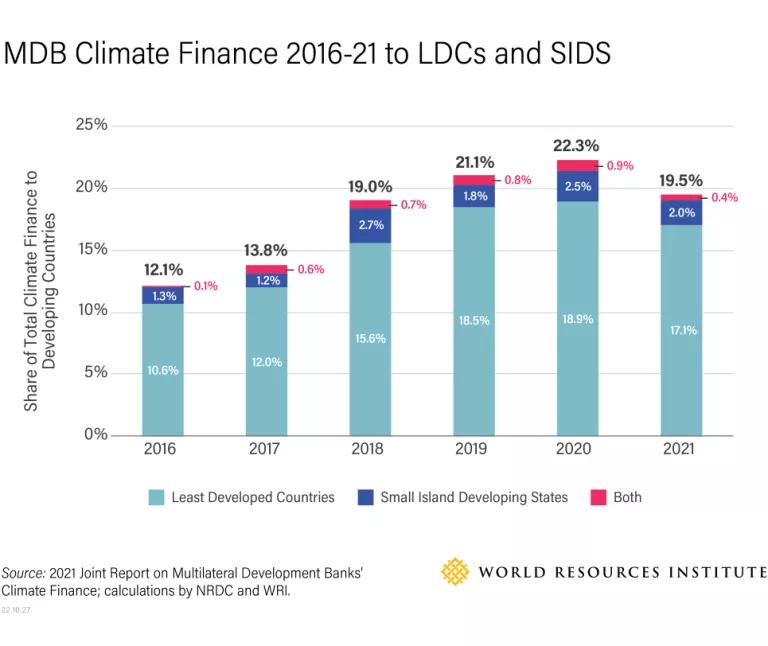
3) MDBs are still funding fossil fuels
Despite a large consensus across studies, including by the International Energy Agency, that developing new coal, oil and gas fields is incompatible with the Paris Agreement’s target of keeping warming to 1.5 degrees C (2.7 degrees F), MDBs are continuing to invest in fossil fuels, undermining the benefits of their climate finance.
MDBs don’t report on their fossil fuel finance as they do climate finance, but they should. Based on data collected and analyzed by Oil Change International (OCI), MDBs provided $4.6 billion in financing for fossil fuel projects in 2021, a $666 million increase on 2020 levels. Importantly, this figure does not include most indirect support, such as lending to financial intermediaries that finance fossil fuels, nor policy-based lending that can encourage fossil fuel production through regulatory reforms.
According to OCI’s database, none of the MDB commitments for fossil fuels in 2021 targeted energy access needs. The IsDB Group supported the largest amount of finance listed for a single project; a three-year $4.5 billion syndicated loan to import crude oil, petroleum products and liquified natural gas (LNG) from Saudi Arabia to Pakistan. This is followed by a 20-year guarantee from the WBG for up to nearly $1 billion for an LNG plant in Uzbekistan which also received a $200 million loan from the EBRD and is co-financed with a $100 million loan from the AIIB. Even the EIB, the MDB considered to have the most progressive energy policy for fossil fuel financing, approved a combined $75 million in lending in 2021 for the construction of a 123 km LNG pipeline between North Macedonia and Greece.
Many MDB shareholders, from both developed and developing countries, are calling for an end to international public financing for fossil fuels and to shift this funding into clean energy. As most MDBs pledged to align all new activities in 2023-25 with the Paris Agreement, their quantitative reporting should include both climate and fossil financing side by side to give a sense of the net climate finance for each institution. These provisions must also extend to indirect financing modalities since Paris alignment must apply to all MDB activities.
The Urgent:
1) MDBs should review the ambition of their climate finance targets
MDBs have hit their collective 2025 climate finance target four years early, yet the financing gap for climate continues to get bigger. It may be time for MDBs to review, reassess, and increase their collective ambition. At the same time, some MDBs have yet to reach their individual climate finance goals, so they need to ramp up their efforts to stay on track. MDBs that have hit their targets should consider setting more ambitious goals to keep up the momentum given developing countries’ climate finance needs still far outpace available resources.
2) MDBs need to increase adaptation finance
The absolute amount of adaptation finance to low- and middle-income economies increased by $4.3 billion (32%) from 2020 to $17.6 billion in 2021, nearly hitting their collective 2025 target of $18 billion four years early. However, with yearly adaptation costs estimated at $70 billion in developing countries and expected to rise to $140-300 billion in 2030, it is far from closing the gap between adaptation finance flows and what is needed to avoid severe economic and human impacts from climate change in developing countries. Heeding the goal in the Paris Agreement to achieve a balance between adaptation and mitigation finance and acknowledging the increasing severity of and disproportionate climate impacts in developing countries, MDBs should aim to boost investment in climate adaptation at a much faster pace.
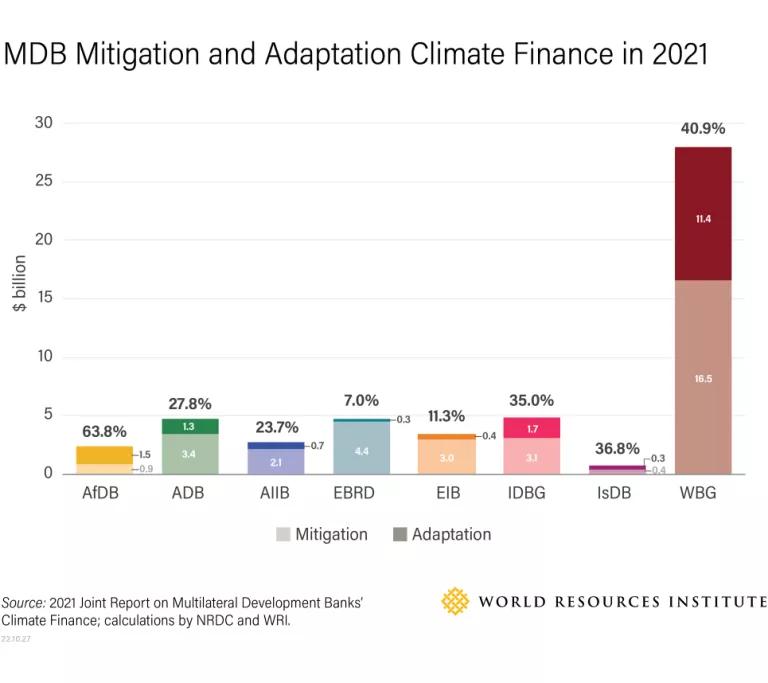
Note: percentage on bar denotes share of climate finance for adaptation
3) Transparency needs to improve
The joint report data are self-reported and not independently verified by a third party. MDBs do not publish details on how climate finance assessments are made on a project-by-project basis. This lack of transparency and information disclosure decreases credibility and increases the risk of over- or under-reporting.
For example, Oxfam has found that the World Bank’s (IBRD and IDA) reported climate finance figures in 2020 may be off by as much as $7 billion, or 40%, in either direction. Increased transparency that facilitates third-party verification can greatly increase the credibility of MDB climate finance data. Additionally, the frequent changes in the format and data included in the annual joint reports make assessments of trends over time challenging.
MDBs should report data in clear and consistent ways year after year. If changes to scope or format are made, they should be clear about how this affects comparability with previous reports, with the historically comparable datasets made publicly available to enhance public accountability and evaluation.




